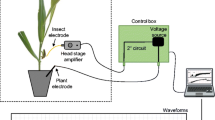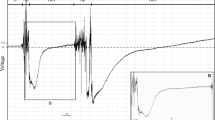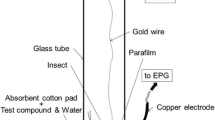Abstract
In this study, we use for the first time the electropenetrography (EPG) technique to characterize and describe the feeding activities of Collaria scenica (Stål) adults and their respective waveforms on wheat, Triticum aestivum L. plants. It comprised of four waveforms, two related to non-feeding (Np and R) and two with feeding activities (CR and I). The Np wave represents the insect resting or walking on the plant surface (75% of the recording time). R wave was associated to sensory evaluation of leaf surface with the tip of the labium (labial dabbing activity—ca. 1% of the recording time). Feeding activities were of relative short duration; cell rupture waveform (CR—ca. 49 min—ca. 15% of the recording time) was highly irregular due to constant movement of the stylets internally in the plant tissue. The waveform I (ca. 28 min—ca. 9% of the recording time) showed stereotypical and repetitive pattern and represents ingestion of the cell contents previously degraded via cell-rupturing activities. The damage caused by C. scenica in wheat leaflets is a result of cell-rupturing activities, generated by action of digestive enzymes plus mechanical action of serrated mandibular stylets. This results in whitish streaks, dots, or spots on the leaflet of wheat plants which cause significant damage and eventually plants’ death.




Similar content being viewed by others

References
Auad AM, Pimenta DS, Silva DM, Monteiro PH, Resende TT (2011) Collaria oleosa (Hemiptera: Miridae) on Brachiaria ruziziensis and Penissetum purpureum (Poaceae): Characterization of injury and biological aspects. Rev Colomb Entomol 37:244–248
Backus EA, Cervantes FA, Guedes RNC, Li AY, Wayadande AC (2019) AC–DC electropenetrography for in-depth studies of feeding and oviposition behaviors. Ann Entomol Soc Am 112:236–248
Backus EA, Cline AR, Ellerseick MR, Serrano MS (2007) Lygus hesperus (Hemiptera: Miridae) feeding on cotton: new methods and parameters for analysis of nonsequential electrical penetration graph data. Ann Entomol Soc Am 100:296–310
Backus EA, Rangasamy M, Stamm M, McAuslane HJ, Cherry R (2013) Waveform library for chinch bugs (Hemiptera: Heteroptera: Blissidae): characterization of electrical penetration graph waveforms at multiple input impedances. Ann Entomol Soc Am 106:524–539
Backus EA, Serrano MS, Ranger CM (2005) Mechanisms of hopperburn: an overview of insect taxonomy, behavior, and physiology. Annu Rev Entomol 50:125–151
Briceño A (2007) Otra chinche más en el pasto kikuyo del Estado Mérida. Bol Divulg 60:31–32
Carlessi LR, Corseuil E, Salvadori JR (1999) Aspectos biológicos e morfométricos de Collaria scenica (Stal)(Hemiptera: Miridae) em trigo. An Soc Entomol Bras 28:65–73
Cervantes FA, Backus EA, Godfrey L, Akbar W, Clark TL (2016) Characterization of an EPG waveform library for adult Lygus lineolaris and Lygus hesperus (Hemiptera: Miridae) feeding on cotton squares. Ann Entomol Soc Am 109:684–697
Cooper WR, Spurgeon DW (2013) Feeding injury to cotton caused by Lygus hesperus (Hemiptera: Miridae) nymphs and prereproductive adults. Environ Entomol 42:967–972
Chapman RF (1998) The insects: structure and function, 4th edn. Cambridge University Press, Cambridge, p 770
Dugravot S, Backus EA, Reardon BJ, Miller TA (2008) Correlations of cibarial muscle activities of Homalodisca spp. sharpshooters (Hemiptera: Cicadellidae) with EPG ingestion waveform and excretion. J Insect Physiol 54:1467–1147
Ferreira PSF, Silva ER, Coelho LBN (2001) Miridae (Heteroptera) fitófagos e predadores de Minas Gerais, com ênfase em espécies com potencial econômico. Iheringia 91:159–169
Gaitán CAR, Riveros GD (2002) El chinche de los pastos (Collaria scenica): Una amenaza para la producción lechera en la Sabana de Bogotá y valles de Ubaté y Chiquinquirá. Instituto Colombiano Agropecuário, Colombia, p 22
Goellner CI, Floss E (2001) Insetos-pragas da cultura da aveia: Biologia controle e manejo. Universidade de Passo Fundo, Passo Fundo, p 98
Granja EM, Triana NDCB (1998) La chinche de los pastos Collaria scenica Stal. en la Sabana de Bogotá. Bogotá, Colombia, p 66
Kalvelage H (1988) Collaria scenica (Stal, 1859) (Hemiptera: Miridae): Praga de gramíneas forrageiras na Região do Planalto Catarinense, Brasil. An Soc Entomol Bras 17:221–222
Large EC (1954) Growth stages in cereals. Illustration of the Feekes scale. Plant Pathol 3:128–129
Lucini T, Panizzi A (2018a) Electropenetrography (EPG): a breakthrough tool unveiling stink bug (Pentatomidae) feeding on plants. Neotrop Entomol 47:6–18
Lucini T, Panizzi AR (2018b) EPG monitoring of the Neotropical brown-stink bug, Euschistus heros (F.), on soybean pods: an electrical penetration graph-histology analysis. J Insect Sci 18(5):1–14
Lucini T, Panizzi AR, Backus EA (2016) Characterization of an EPG waveform library for redbanded stink bug, Piezodorus guildinii (Hemiptera: Pentatomidae), on soybean plants. Ann Entomol Soc Am 109:198–210
Melo MC, Dellapé PM, Carpintero DL, Coscarón MDC (2004) Reduviidae, Miridae y Lygaeoidea (Hemiptera) recolectados en Colonia Carlos Pellegrini (Esteros de Iberá, Corrientes, Argentina). Rev Soc Entomol Arg 63:59–67
Menezes M (1990) Collaria oleosa (Distant, 1883) (Hemiptera: Miridae), a new pest of forage grasses in southeastern Bahia, Brazil. Agrotrópica 2:113–118
Miles PW, Taylor GS (1994) ‘Osmotic pump’ feeding by coreids. Entomol Exp Appl 73:163–173
Mitchell PL, Cooke SB, Smaniotto LF (2018) Probing behavior of Nezara viridula on soybean: Characterization and comparison of electrical penetration graph (EPG) waveforms on vegetative and reproductive plant structures. J Agric Urban Entomol 34:19–43
Naranjo N, Montero DA, Sáenz A (2013) Control de la chinche de los pastos Collaria scenica (Hemiptera: Miridae) con nematodos entomopatógenos en invernadero. Rev Bras Ciênc Agrár 8:90–94
Nogueira BCF, Coelho LA, Martins DS, Barcellos BD, Sartori SR, Ferreira PSF (2019) Associações de percevejos mirídeos (Hemiptera: Miridae) com plantas no Brasil. Biológico 81:1–30
Ribeiro LK, Tokarski A, Rech C, Lara CA, Nardi C (2020) New record of Microtechnites bractatus (Say) (Hemiptera: Miridae) infesting Crotalaria spp. and injuries of Miridae in cultivated plants in the State of Paraná, Brazil. Rev Bras Entomol 64:e20200027
Salvadori JR (2000) Pragas da cultura da cevada. Embrapa Trigo, Passo Fundo, p 48
Schuh RT (2002–2013) On-line systematic catalog of plant bugs (Insecta: Heteroptera: Miridae). <http://research.amnh.org/pbi/catalog/>, Accessed 24 Nov 2020.
Serteyn L, Ponnet L, Backus EA, Francis F (2020) Characterization of electropenetrography waveforms for the invasive heteropteran pest, Halyomorpha halys, on Vicia faba leaves. Arthropod Plant Interact 14:113–126
Silva DB, Alves RT, Ferreira PSF, Camargo AJA (1994) Collaria oleosa (Distant, 1883) (Heteroptera: Miridae), uma praga potencial na cultura do trigo na região dos cerrados. Pesqui Agropec Bras 29:2007–2012
Walker GP (2000) A beginner’s guide to electronic monitoring of homopteran probing behavior. In: Walker GP, Backus EA (eds) Principles and applications of electronic monitoring and other techniques in the study of homopteran feeding behavior. Entomological Society of America, Lanham, pp 14–40
Funding
This study was partially supported by Conselho Nacional de Desenvolvimento Científico e Tecnológico (CNPq) grant 302293/2017-5 to ARP, and Coordenação de Aperfeiçoamento de Pessoal de Nível Superior (CAPES) by a post doctorate scholarship to TL (process number 88887.371769/2019-00). We also thank the Embrapa Trigo, Passo Fundo, RS for the support and for providing facilities.
Author information
Authors and Affiliations
Contributions
CR and TL co-planned, analyzed, and co-wrote the manuscript; ARP co-planned and co-wrote the manuscript; CN co-wrote the manuscript.
Corresponding author
Ethics declarations
Research activity registered at the Sisgen databank under number AA93702. Registered at the Publication Committee of Embrapa Trigo under number 21205.002125/2020-08.
Conflict of interest
The authors declare no competing interests.
Additional information
Edited by Fábio S Nascimento
Publisher’s Note
Springer Nature remains neutral with regard to jurisdictional claims in published maps and institutional affiliations.
Supplementary Information
Rights and permissions
About this article
Cite this article
Rech, C., Lucini, T., Panizzi, A.R. et al. Feeding Behavior of Collaria scenica (Stål) (Hemiptera: Miridae) on Wheat Plants: an EPG Waveform Characterization. Neotrop Entomol 50, 366–373 (2021). https://doi.org/10.1007/s13744-021-00859-1
Received:
Accepted:
Published:
Issue Date:
DOI: https://doi.org/10.1007/s13744-021-00859-1



